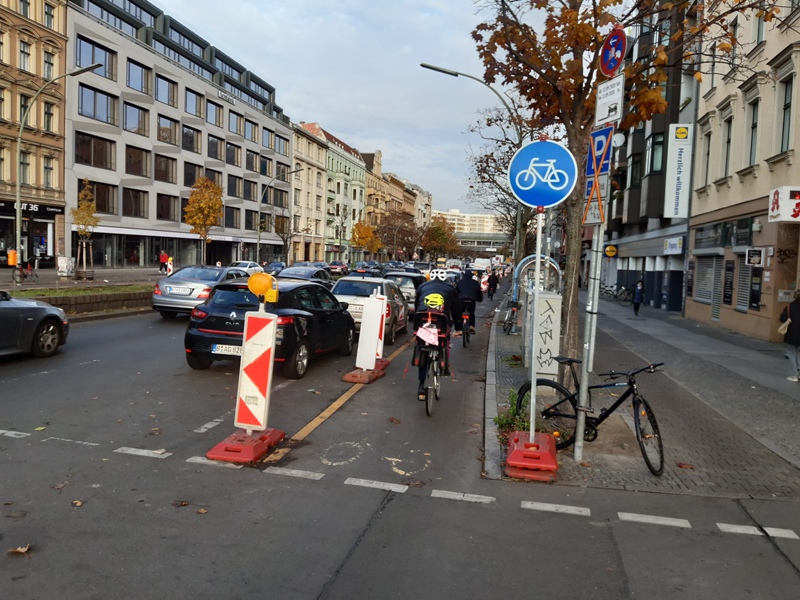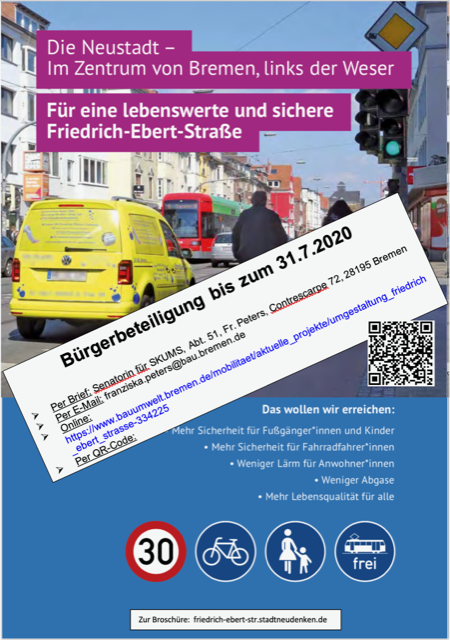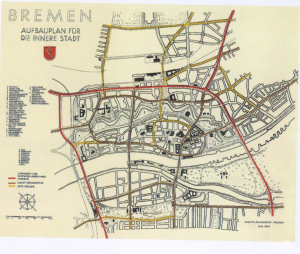Why we need empathy on the road, or what does „Black Lives Matter“ and the current discourse on systemic racism have in common with transportation politics? Source: Mohamed Hassan auf pixabay
Source: Mohamed Hassan auf pixabay
Category Archives: Verkehrswende
Pavement Parking and Accessibility
There is hardly an issue in Bremen that is as heated as the parking of cars in residential areas. Questions like these arise: Who does resident parking help? Is parking on pavements permissible? And if so, under what conditions? What rights do pedestrians have? The debate is characterised by assumptions and unsubstantiated claims on the part of both proponents and opponents of a sustainable traffic turnaround. Reason enough to take a look at the binding provisions of road and traffic law in a series of articles on Bremenize. Continue reading Pavement Parking and Accessibility
Protected Bike Lanes in Corona Times: Do it Bremen!
After Corona (2): When will Bremen get Protected Bike Lanes?
Shortly before the outbreak of the pandemic, several protected bike lanes were announced in Bremen. In the meantime, we in Germany are in the middle of the second wave of infection – with a kind of “lockdown light”. Already during the first wave, cycle lanes were quickly and easily set up on multi-lane roads in many cities around the world and also in many German cities. These cities have thus responded to the changed conditions and the changing needs of their citizens during the pandemic.
In contrast, Bremen has so far not responded to the pandemic with a single pop-up cycle path.

Berlin, Kottbusser Damm: pop-up bike lane. Photo: Olaf Dilling
Continue reading Protected Bike Lanes in Corona Times: Do it Bremen!
Platz Da! Parliament Agrees Compromise
Platz Da! (There’s Space!) Bremen has collected 6,000 signatures in the Hanseatic city and held endless debates with politicians to make more space in Bremen for all people. Platz da! has fought for state-wide parking management, for the abolition of parking on footpaths and cycle paths, for a proper enforcement of parking bans and for a transport transition in the city. The “comprehensive” aspect of their proposals was turned down by the ruling coalition, principally by the Social Democrats, but at least parking management is to be introduced in some districts – Mitte, Östliche Vorstadt, Schwachhausen, Findorff, Walle and Neustadt. It has been a long battle, but on 17 November 2020 parliament agreed the compromise. As an admonition and reminder for the members of parliament, the activists came to the Bürgerschaft…
Einfach Einsteigen: A Public Transport Revolution?
The climate crisis and need for a transformation to a sustainable traffic and transport system demand feasible concepts. The initiative “Einfach Einsteigen” (not exactly translateable, but close to Simply Enter; Get on (board)/hop on) has developed a calculated concept for financing the expansion and operation of Bremen’s local transport system. A role model for other cities as well?
Here is some background information on “Einfach Einsteigen” (hereafter abbreviated as “we”) financing concept for local transport as well as its assessment by the Bremen Senate. If the concept is implemented, the initiative claims, local transport in Bremen can be operated without tickets as well as comprehensively expanded.(Note: this is operating under German law) Continue reading Einfach Einsteigen: A Public Transport Revolution?
Continue reading Einfach Einsteigen: A Public Transport Revolution?
We need your opinion here in Bremen
As the summer holidays hit in, transport senator Maike Schaefer is seeking the public’s opinion and expertise regarding two major projects:
The VEP 2025 (Verkehrsentwicklungsplan = traffic development plan)
and the remake of a main road, Friedrich-Ebert-Straße in the Neustadt. 
To make your life easier, a citizens’ initiative has already developed some helpful ideas. Have a look into their brochure.
As you can see in the poster above, both projects have tight deadlines for your ideas to be submitted: The VEP participation ends at the 2nd of August, and your ideas for the Friedrich-Ebert-Straße need to be handed in by the 31st of July.
Zebra Crossing – no chance in Bremen?
There are hardly any zebra crossings in Bremen. Why is that so? Don’t they offer pedestrians safety? Do they disturb the car traffic? Are they too expensive to produce?
Zebra crossings are – strictly speaking – a stopgap in places where car traffic dominates urban traffic. They were made in Britain, like this probably most famous zebra crossing photo in Abbey Road with the Beatles.

The protective effect of zebra crossings is beyond doubt. As the guidelines state: “MSDS are one of several ways of protecting pedestrians when crossing the road (see VwV on §25 StVO)” (German guidelines for pedestrian crossings, (R-FGÜ 2001). The federal states were asked to introduce these guidelines and to apply them from January 1, 2002. Continue reading Zebra Crossing – no chance in Bremen?
1970s Tools For 2030 Aims

Is your head stuck in the 1970s? Most of us like to think that we fit well with the modern world. We appreciate democracy. We support equal rights for all. We are tolerant and open to new ways. Yet when it comes to transport policy, many of us can’t get out of 1970s thinking.
This is the problem that haunts Transport Transition advocates. We want to reclaim the cities for people by reducing the use of motorised vehicles. But whenever proposals are presented that will do just this, so many of us cannot think beyond the problems of 1970s traffic management. Where will the cars go if they can’t go here? How can shops get their supplies without lorries? How can residents park their cars if not in the street? Even transport activists find it difficult to get over this way of thinking. For as much as it is embedded in official government policy, it is no surprise that the transport sector has failed miserably to reduce its carbon emissions. Continue reading 1970s Tools For 2030 Aims